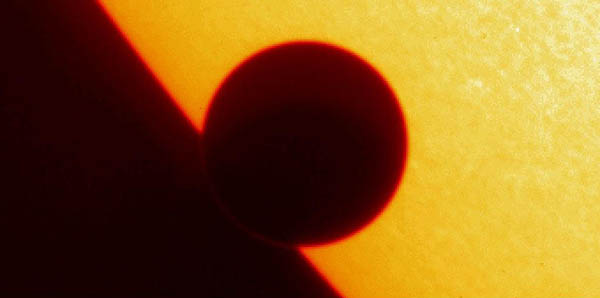
Bates invites public to safe viewing of transit of Venus
Faculty in the Bates College departments of geology and of physics and astronomy invite Lewiston-Auburn residents to view the highly anticipated transit of Venus in an event starting at 5:30 p.m. Tuesday, June 5, on the Olin Arts Center Terrace, 75 Russell St.
The transit begins around 6 p.m. Weather permitting, the viewing will continue until the sun sets below the tree line, around 7 p.m. For more information, please call 207-786-6490.
Though it’s an exciting and rare astronomical event, the transit does pose a risk because of the hazards of viewing the sun without proper eye protection. The Bates event is a safe opportunity to watch the phenomenon.
“We have two small telescopes well-suited for observing the sun,” said Nicole Hastings, assistant in instruction in physics and astronomy, “and are glad to offer the use of them and invite people to view this rare event.
“One telescope has a hydrogen alpha filter attached to it, which will allow viewers to see solar prominences, filaments and sun spots along with the transit of Venus.”
Bates faculty and staff will be on hand to operate the telescopes and discuss the event. Viewers will see a dark spot crossing the disk of the sun as the planet Venus passes directly between Earth and sun. A relatively unusual event in the solar system, the most recent previous transits of Venus occurred in 1882 and 2004, and the next will take place in 2117.
Viewers in much of the Pacific region will be able to see the entire transit, but in New England the sun will set soon after the transit begins. Depending on their view of the horizon, observers will have an hour or so to see the transit before the sun sets.
The sun should never be viewed directly, whether with an instrument or the naked eye, as serious and permanent eye damage can result. Safe viewing of the transit requires a telescope or binoculars equipped with very dense sun-viewing filters, as for viewing a solar eclipse; or an image from the eyepiece of a telescope or binoculars can be projected onto a white card serving as a small viewing screen.
A transit of Venus was first recorded in 1639, less than 30 years after the first astronomical applications of the newly invented telescope. The transits of 1761 and 1769 inspired the first global scientific research enterprise.
“It was quite remarkable,” says Gene Clough, lecturer in geology and physics at Bates. “People sailed all around the world to observe the transit.”
It was hoped that careful observation from many locations would permit an improved determination of the size of the Earth’s orbit around the sun. “There were many difficulties and the data were harder to interpret than had been anticipated,” Clough says, “but historically it was a very important episode.”
This year’s transit comes just days before the June 9 opening of “Starstruck: The Fine Art of Astrophotography” at the Bates College Museum of Art.





